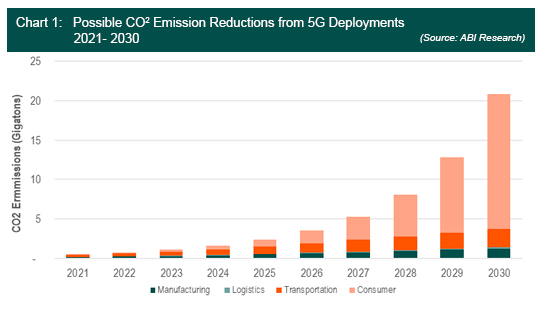The Role of ICT for Global CO2 Emissions
|
NEWS
|
The topic of sustainability has never been higher on the societal agenda than it is today. With the Paris Agreement signed in April 2016, 175 world leaders committed to limiting the global temperature increase to below 2° Celsius (C) compared to pre-industrial levels and pursued efforts to limit temperature increases even further to 1.5° C. To achieve this, the signatories are committing to becoming net carbon neutral by the middle of this century. The scientific community in the form of the United Nations’ Intergovernmental Panel on Climate Change (IPCC) makes an even more drastic case. Maintaining the current trajectory, the world will reach the crucial threshold of a 1.5° C temperature increase compared to pre-industrial levels by 2030. Consequentially, global net emissions of carbon dioxide (CO2) would need to fall by 45% from 2010 levels (which corresponds to almost fifteen gigatons) by 2030.
As the Information and Communications Technology (ICT) industry is making noticeable contributions to energy consumption and emissions of greenhouse gases. Though according to the Global Enabling Sustainability Initiative (GeSI), the ICT sector is expected to account for up to 20% of the global electricity consumption levels by 2030, so any effort to reduce carbon emissions will have to include these technologies, with 5G at the heart of it. Not only can 5G networks create a more sustainable and more energy-efficient mobile broadband layer in the consumer domain, but they will also be an important building block to reduce energy consumption (and therefore CO2 emissions) in the enterprise domain.
How Can 5G Contribute to More Sustainability?
|
IMPACT
|
At first sight 5G is inherently a more energy-consuming technology due to massive Multiple Input Multiple Output (mMIMO) units that have stringent power requirements. At the same time, however, mMIMO antennas and beamforming can handle significantly more network traffic, which makes 5G more energy-efficient than 4G. While a 5G network can be much more energy-efficient than a 4G network, based on energy consumption per single Megabit per Second (Mbps) of capacity, the far greater potential for energy savings (and subsequently CO2 emission reductions) come from an indirect effect of enterprise and consumer digitization. For example, 5G allows manufacturers to deploy predictivity, preventative, and remote maintenance applications, which will limit the amount of travel that engineers must make for on-site maintenance. In the transportation sector, 5G deployments can improve efficiency of airport operations, reducing the grounding time for each airplane.
To understand these indirect effects better, ABI Research has recently developed a model that quantifies energy and CO2 emission savings for the manufacturing, logistics, and transportation domains. Furthermore, it looked at 5G as an important ingredient to changing people’s everyday lives when it comes to online shopping and remote working.
As Chart One shows, the lion’s share of emission savings stems from the consumer domain, specifically from the drastic energy savings enabled by remote working. Assuming that only a small fraction of global commuter journeys can be prevented by remote working, this alone could reduce CO2 emissions by more than fifteen Gigatons (Gt). Beyond this, the model also shows tremendous energy saving opportunities for factory and warehouse operators. A single smart factory using 5G for predictive, preventative, and remote maintenance, as well as for deployment of Automated Guided Vehicles (AGVs), is expected to save energy in the range of 103 tons of CO2 emissions, while the average warehouse operator will save 695 tons of CO2 emissions by 2030 by deploying enterprise 5G.

Call to Action
|
RECOMMENDATIONS
|
All of this shows that 5G is a pivotal building block for telecom sustainability strategies and should become an integral part of enterprise verticals considerations as well.
To unleash this potential, however, the pace of 5G rollout is important, as the move towards a more sustainable way of production is pressing and the climate crisis cannot be postponed.
Especially in the enterprise domain, 5G adoption has some critical room for improvement. To drive this, the entire industry needs to embrace the fact this is a consolidated ecosystem effort and therefore requires close collaboration with implementing enterprises to understand their pain points and key requirements. To make optimum use of different areas of expertise within the market, and to drive down Total Cost of Ownership (TCO) for enterprises, co-creation initiatives will be the most promising models to achieve this. As this allows to combine resources that are already existing in the market today, it minimizes time-to-market.
Furthermore, more market education is needed to drive adoption of enterprise-grade cellular connectivity. As 3GPP Release 16 capable enterprise-grade chipsets are still not available (and will probably not enter the market until 2023), the telecom industry needs to position 4G deployments as an intermediary technology that enterprises can deploy as of now. To do this, enterprises need more education on the fact that 85-90% of today’s enterprise use cases can already be addressed with 4G connectivity. On a technology front, system integrators and infrastructure vendors need to work on solutions that provide an easy and effortless upgrade path from 4G (or non-standalone 5G) to standalone 5G, which is what enterprises are ultimately waiting for.
To prevent enterprises from looking at non-cellular technology alternative technologies, it is important to position 4G as a good enough technology for now and guide them through an upgrade path once the device ecosystem for standalone 5G matures.




